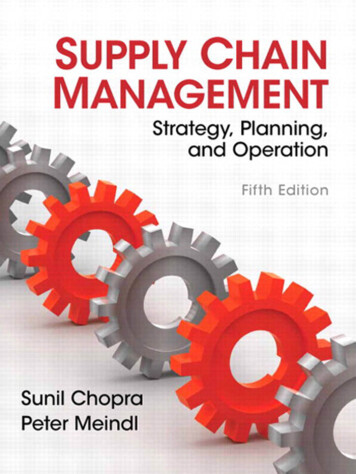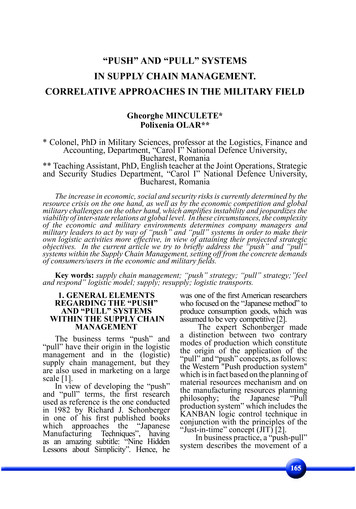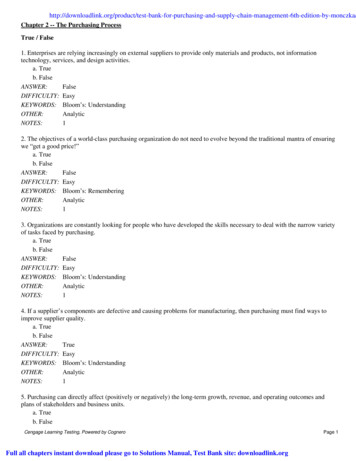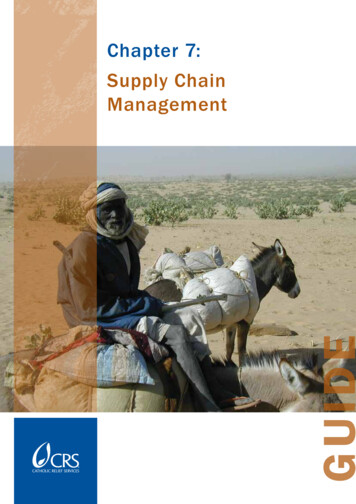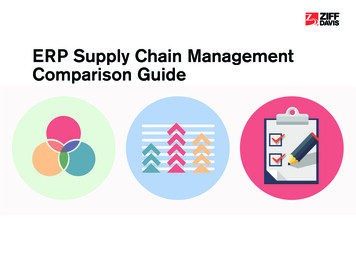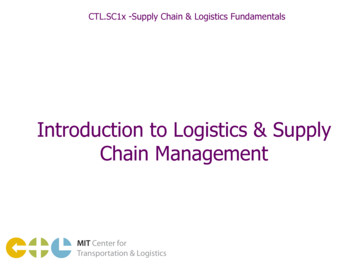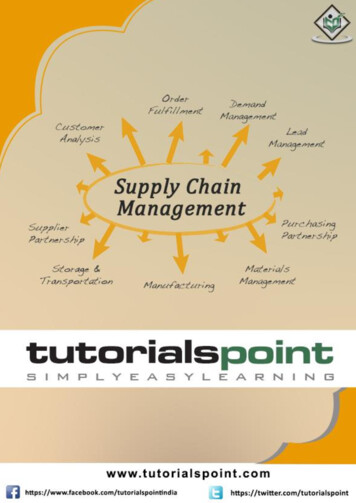
Transcription
Supply Chain ManagementAbout the TutorialSupply Chain management can be defined as the management of flow of products andservices, which begins from the origin of products and ends with the product’sconsumption at the end-user.This is a brief introductory tutorial that explains the methodologies applied in the rapidlygrowing area of Supply Chain Management in an organization.AudienceThis tutorial will be useful for students from management streams who aspire to learnthe basics of Supply Chain Management. Professionals, regardless of which sector orindustry they belong to, can use this tutorial to learn how to apply the methods ofSupply Chain Management in their respective project environments.PrerequisitesThe readers of this tutorial are expected to have a general idea of what supply chainmanagement means and what place and importance it holds in an organization.Disclaimer & Copyright Copyright 2016 by Tutorials Point (I) Pvt. Ltd.All the content and graphics published in this e-book are the property of Tutorials Point(I) Pvt. Ltd. The user of this e-book is prohibited to reuse, retain, copy, distribute orrepublish any contents or a part of contents of this e-book in any manner without writtenconsent of the publisher.We strive to update the contents of our website and tutorials as timely and as preciselyas possible, however, the contents may contain inaccuracies or errors. Tutorials Point (I)Pvt. Ltd. provides no guarantee regarding the accuracy, timeliness or completeness ofour website or its contents including this tutorial. If you discover any errors on ourwebsite or in this tutorial, please notify us at contact@tutorialspoint.com.i
Supply Chain ManagementTable of ContentsAbout the Tutorial . iAudience . iPrerequisites . iDisclaimer & Copyright. iTable of Contents . ii1.SCM – INTRODUCTION . 1Supply Chain Management – Advantages . 2Supply Chain Management – Goals . 22.SCM – PROCESS . 4Plan . 4Develop (Source) . 4Make . 4Deliver. 5Return . 53.SCM – PROCESS FLOW . 6Types. 6Material Flow . 6Information Flow . 7Money Flow . 74.SCM – FLOW COMPONENTS. 8Transportation . 8Warehousing . 9Sourcing and Procurement . 10Returns Management . 10Post-Sales Service. 11ii
Supply Chain Management5.SCM – DECISION PHASES . 12Supply Chain Strategy . 12Supply Chain Planning . 13Supply Chain Operations . 136.SCM – PERFORMANCE MEASURES . 14Quantitative Measures. 14Non-Financial Measures . 14Financial Measures. 167.SCM – STRATEGIC SOURCING . 17Understanding the Spend Category . 18Supplier Market Assessment . 18Supplier Survey . 19Building the Strategy . 20RFx Request . 20Selection . 20Communication with New Suppliers . 208.SCM – MAKE VS BUY . 22Business Strategy . 23Risks . 24Economic Factors . 259.SCM: NETWORKS. 27Network Models . 2810. SCM – INVENTORY MANAGEMENT . 30Role of Inventory . 31Optimization Models. 31Mixed Integer Linear Programming . 31iii
Supply Chain ManagementStochastic Modeling . 32Uncertainty Modeling . 32Bi-level Optimization . 3211. SCM – PRICING & REVENUE MANAGEMENT . 33RM for Multiple Customer Segments . 33RM for Perishable Assets . 34RM for Seasonal Demands . 34RM for Bulk and Spot Demands. 3512. SCM – INTEGRATION . 36Push System . 36Pull System. 37Differences in Push and Pull System . 37Push & Pull System . 38Demand-Driven Strategies . 3913. SCM – ROLE OF IT . 41Electronic Commerce . 41Electronic Data Interchange . 42Barcode Scanning . 43Data Warehouse . 43Enterprise Resource Planning (ERP) Tools . 4314. SCM – AGILE AND REVERSE SUPPLY CHAINS. 45Agile Supply Chain . 45Reverse Supply Chain . 46iv
1. SCM – IntroductionSupply Chain ManagementSupply Chain Management can be defined as the management of flow of products andservices, which begins from the origin of products and ends at the product’sconsumption. It also comprises movement and storage of raw materials that areinvolved in work in progress, inventory and fully furnished goods.The main objective of supply chain management is to monitor and relate production,distribution, and shipment of products and services. This can be done by companies witha very good and tight hold over internal inventories, production, distribution, internalproductions and sales.In the above figure, we can see the flow of goods, services and information fromproducer to the consumer. The picture depicts the movement of a product fromproducer to the manufacturer, who forwards it to the distributor for shipment.distributor in turn ships it to the wholesaler or retailer, who further distributesproducts to various shops from where the customers can easily get the product.thetheThetheSupply chain management basically merges the supply and demand management. Ituses different strategies and approaches to view the entire chain and work efficiently ateach and every step involved in the chain. Every unit that participates in the processmust aim to minimize the costs and help the companies to improve their long termperformance, while also creating value for its stakeholders and customers. This processcan also minimize the rates by eradicating the unnecessary expenses, movements andhandling.Here we need to note that supply chain management and supply chain eventmanagement are two different topics to consider. The Supply Chain Event Managementconsiders the factors that may interrupt the flow of an effective supply chain; possiblescenarios are considered and accordingly, solutions are devised for them.1
Supply Chain ManagementSupply Chain Management – AdvantagesIn this era of globalization where companies compete to provide the best qualityproducts to the customers and satisfy all their demands, supply chain management playsa very important role. All the companies are highly dependent on effective supply chainprocess.Let’s take a look at the major advantages of supply chain. The key benefits of supplychain management are as follows: Develops better customer relationship and service. Creates better delivery mechanisms for products and services in demand withminimum delay. Improvises productivity and business functions. Minimizes warehouse and transportation costs. Minimizes direct and indirect costs. Assists in achieving shipping of right products to the right place at the right time. Enhances inventory management, supporting the successful execution of just-intime stock models. Assists companies in adapting to the challenges of globalization, economicupheaval, expanding consumer expectations, and related differences. Assists companies in minimizing waste, driving out costs, and achievingefficiencies throughout the supply chain process.These were some of the major advantages of supply chain management. After taking aquick glance at the concept and advantages on supply chain management, let us take alook at the main goals of this management.Supply Chain Management – GoalsEvery firm strives to match supply with demand in a timely fashion with the mostefficient use of resources. Here are some of the important goals of supply chainmanagement: Supply chain partners work collaboratively at different levels to maximizeresource productivity, construct standardized processes, remove duplicate effortsand minimize inventory levels. Minimization of supply chain expenses is very essential, especially when there areeconomic uncertainties in companies regarding their wish to conserve capital. Cost efficient and cheap products are necessary, but supply chain managers needto concentrate on value creation for their customers.2
Supply Chain Management Exceeding the customers’ expectations on a regular basis is the best way tosatisfy them. Increased expectations of clients for higher product variety, customized goods,off-season availability of inventory and rapid fulfillment at a cost comparable toin-store offerings should be matched. To meet consumer expectations, merchants need to leverage inventory as ashared resource and utilize the distributed order management technology tocomplete orders from the optimal node in the supply chain.Lastly, supply chain management aims at contributing to the financial success of anenterprise. In addition to all the points highlighted above, it aims at leading enterprisesusing the supply chain to improve differentiation, increase sales, and penetrate newmarkets. The objective is to drive competitive benefit and shareholder value.3
2. SCM – ProcessSupply Chain ManagementSupply chain management is a process used by companies to ensure that their supplychain is efficient and cost-effective. A supply chain is the collection of steps that acompany takes to transform raw materials into a final product. The five basiccomponents of supply chain management are discussed below:PlanThe initial stage of the supply chain process is the planning stage. We need to develop aplan or strategy in order to address how the products and services will satisfy thedemands and necessities of the customers. In this stage, the planning should mainlyfocus on designing a strategy that yields maximum profit.For managing all the resources required for designing products and providing services, astrategy has to be designed by the companies. Supply chain management mainlyfocuses on planning and developing a set of metrics.Develop (Source)After planning, the next step involves developing or sourcing. In this stage, we mainlyconcentrate on building a strong relationship with suppliers of the raw materials requiredfor production. This involves not only identifying dependable suppliers but alsodetermining different planning methods for shipping, delivery, and payment of theproduct.Companies need to select suppliers to deliver the items and services they require todevelop their product. So in this stage, the supply chain managers need to construct aset of pricing, delivery and payment processes with suppliers and also create the metricsfor controlling and improving the relationships.Finally, the supply chain managers can combine all these processes for handling theirgoods and services inventory. This handling comprises receiving and examiningshipments, transferring them to the manufacturing facilities and authorizing supplierpayments.MakeThe third step in the supply chain management process is the manufacturing or makingof products that were demanded by the customer. In this stage, the products aredesigned, produced, tested, packaged, and synchronized for delivery.Here, the task of the supply chain manager is to schedule all the activities required formanufacturing, testing, packaging and preparation for delivery. This stage is consideredas the most metric-intensive unit of the supply chain, where firms can gauge the qualitylevels, production output and worker productivity.4
Supply Chain ManagementPlanDevelopReturnSupply ChainManagementMakeDeliverDeliverThe fourth stage is the delivery stage. Here the products are delivered to the customerat the destined location by the supplier. This stage is basically the logistics phase, wherecustomer orders are accepted and delivery of the goods is planned. The delivery stage isoften referred as logistics, where firms collaborate for the receipt of orders fromcustomers, establish a network of warehouses, pick carriers to deliver products tocustomers and set up an invoicing system to receive payments.ReturnThe last and final stage of supply chain management is referred as the return. In thestage, defective or damaged goods are returned to the supplier by the customer. Here,the companies need to deal with customer queries and respond to their complaints etc.This stage often tends to be a problematic section of the supply chain for manycompanies. The planners of supply chain need to discover a responsive and flexiblenetwork for accepting damaged, defective and extra products back from their customersand facilitating the return process for customers who have issues with deliveredproducts.5
3. SCM – Process flowSupply Chain ManagementSupply chain management can be defined as a systematic flow of materials, goods, andrelated information among suppliers, companies, retailers, and consumers.TypesThere are three different types of flow in supply chain management: Material flow Information/Data flow Money flowLet us consider each of these flows in detail and also see how effectively they areapplicable to Indian companies.Material FlowMaterial flow includes a smooth flow of an item from the producer to the consumer. Thisis possible through various warehouses among distributors, dealers and retailers.The main challenge we face is in ensuring that the material flows as inventory quicklywithout any stoppage through different points in the chain. The quicker it moves, thebetter it is for the enterprise, as it minimizes the cash cycle.The item can also flow from the consumer to the producer for any kind of repairs, orexchange for an end of life material. Finally, completed goods flow from customers totheir consumers through different agencies. A process known as 3PL is in place in thisscenario. There is also an internal flow within the customer company.6
Supply Chain ManagementInformation FlowInformation/data flow comprises the request for quotation, purchase order, monthlyschedules, engineering change requests, quality complaints and reports on supplierperformance from customer side to the supplier.From the producer’s side to the consumer’s side, the information flow consists of thepresentation of the company, offer, confirmation of purchase order, reports on actiontaken on deviation, dispatch details, report on inventory, invoices, etc.For a successful supply chain, regular interaction is necessary between the producer andthe consumer. In many instances, we can see that other partners like distributors,dealers, retailers, logistic service providers participate in the information network.In addition to this, several departments at the producer and consumer side are also apart of the information loop. Here we need to note that the internal information flow withthe customer for in-house manufacture is different.Money FlowOn the basis of the invoice raised by the producer, the clients examine the order forcorrectness. If the claims are correct, money flows from the clients to the respectiveproducer. Flow of money is also observed from the producer side to the clients in theform of debit notes.In short, to achieve an efficient and effective supply chain, it is essential to manage allthree flows properly with minimal efforts. It is a difficult task for a supply chain managerto identify which information is critical for decision-making. Therefore, he or she wouldprefer to have the visibility of all flows on the click of a button.7
4. SCM – Flow ComponentsSupply Chain ManagementAfter understanding the basic flows involved in the supply chain management, we needto consider the different elements present in this flow. Thus, the different components ofthe flow of supply chain are described below.TransportationTransportation or shipment is necessary for an uninterrupted and seamless supply. Thefactors that have an impact on shipment are economic uncertainty and instability,varying fuel prices, customers’ expectations, globalization, improvised technologies,changing transportation industry and labor laws.The major elements that influence transportation should be considered, as it iscompletely dependent on these factors for order completion as well as for ensuring thatall the flows work properly. The major factors are:Long-term DecisionsTransportation managers should acknowledge the supply freight flow and accordinglydesign the network layout. Now, when we say long term decision, we mean that thetransportation manager has to select what should be the primary mode oftransportation.The manager has to understand the product flows, volume, frequency, seasonality,physical features of products and special handlings necessities, if any. In addition to this,the manager has to make decisions as to the extent of outsourcing to be done for each8
Supply Chain Managementand every product. While considering all these factors, he should carefully consider thefact that the networks need not be constant.For example, in order to transport stock to regional cross dock facilities for sorting,packaging and brokering small loads to individual customers, stock destinations can beassembled through contract transportation providers.Lane Operation DecisionsThese functional decisions stress on daily freight operations. Here, the transportationmanagers work on real time information on products’ requirements at different systemnodes and must collaborate every move of the product that is both inbound andoutbound shipping lanes so as to satisfy their services demands at the minimal possiblecost.Managers who makeopportunities for theirimmediately, wheneverthey are saving cost ongood decisions easily handle information and utilize theown profit and assure that the product is moved to themit is demanded, that too in the right quantity. At the same time,transportation also.For example, a shipment has landed from a supplier who is based in New Jersey and inthe same week, a product needs to be dispatched to New York as it becomes availablefor movement. If the manager is aware of this information in advance, he would prepareeverything as per the demand and the products could be shipped out immediately.Choice and Mode of CarrierA very important decision to be made is to choose the mode of transportation. With theimprovement in the means of transportation, modes of transport that were not availablein the traditional transportation modes in the past can be now be a preferred choice.For example, rail container service may offer a package that is cost-efficient andeffective as compared to a motor transport. While making a decision, the manager hasto consider the service criteria that need to be met, like the delivery time, date specialhandling requirements, while also taking into consideration the element of cost, whichwould be an important factor.Dock Level OperationsThis involves the last level of decision-making. This comprises planning, routing andscheduling. For example, if a carriage is being loaded with different customers’ orders,the function of the dock-level managers is to assure that the driver is informed of themost efficient route and that loads are placed in the order of the planned stops.WarehousingWarehousing plays a vital role in the supply chain process. In today’s industry, thedemands and expectations of the customers are undergoing a tremendous change. Wewant everything at our door step – that too with efficient price. We can say that themanagement of warehousing functions demands a distinct merging of engineering, IT,human resources and supply chain skills.9
Supply Chain ManagementTo neutralize the efficiency of inbound functions, it is ideal to accept materials in animmediately storable conveyance, like a pallet, case or box. For labeling the structure,tool selection and business process demand the types and quantities of orders that areprocessed. Further, the number of stock-keeping units (SKU’s) in the distribution centersis a crucial consideration.The Warehouse Management Systems (WMS) leads the products to their storage locationwhere they should be stored. The required functionality for the completion andoptimization of receiving, storing and shipping functions is then supplied.Sourcing and ProcurementSourcing and procurement are a vital part of the supply chain management. Thecompany decides if it wants to perform all the exercises internally or if it desires to get itdone by any other independent firm. This is commonly referred as the make vs buydecision, which we will be discussing in brief in another chapter.Returns ManagementReturns management can be defined as the management that invites the merger ofchallenges and opportunities for inbound logistics. A cost-effective reverse logisticsprogram links the available supply of returns with the product information and demandfor repairable items or re-captured materials. We have three pillars that support returnsmanagement processes. These are as follows: Speed: It is a must to have quick and easy returns management and automatedecisions regarding whether to produce return material authorizations (RMAs)and if so, how to process them. Basically, the tools of speed return processinginclude automated workflows, labels & attachments and user profiles.10
Supply Chain Management Visibility: For improving the visibility and predictability, information needs to becaptured initially in the process, ideally prior to delivering the return to thereceiving dock. Most effective and easily implementable approaches for obtainingvisibility are web-based portals, carrier integration and bar-coded identifiers. Control: In case of returns management, synchronizing material movements is acommon issue that needs to be handled. The producers need to be very cautiousand pay close attention to receipts and reconciliation and update the stakeholdersof impending quality issues. In this case, reconciliation activates visibility andcontrol all over t
Supply chain management is a process used by companies to ensure that their supply chain is efficient and cost-effective. A supply chain is the collection of steps that a company takes to transform raw materials into a final product. The five basic compo


